some games I played in
2020
Mario Party Advance
Game Boy Advance
Aug 31 ~ Sep 05
Aug 31 ~ Sep 05
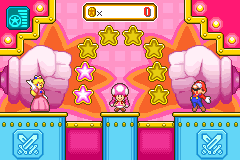
This is a game that kept me busy for a good long while when I first bought it, but I sincerely cannot remember if I ever held much affection for it. Is it good? Is it bad? It's a game that everyone's just kind of allowed to slip away, and I assume for good reason? Only one way to find out!
Although it still retains the board game elements -- the dice, the spaces, the mini-games -- the game is instead more of a... sidequest simulator? You visit houses and resolve their problems; some are as simple as just popping in, others require giving right answers, some demand you go back and forth between locations to obtain vital information or something. It's hard to call it compelling or engaging. It's literally just digital busywork, ticking boxes on the path towards 100% completion, with little in the way of tangible or meaningful rewards.
Still, it's cute to explore the worlds and see all the obscure characters you'll run into, who are given amusing personalities. Sushi the shark is a totally harmless bystander to a half-baked murder mystery, Lakitu is a budding anime dork, Mr. I is hopelessly smitten with Peach. To see one-and-done baddies from Super Mario 64 rendered in sprite form, or even total oddities like the Galoombas from Super Mario World brought back again... it's dopey fanservice, but the fact the writing squeezes in some fun personality or silly 'wrong answer' choices makes it that much more appealing. If the writing were any drier the game would have a lot less going for it.
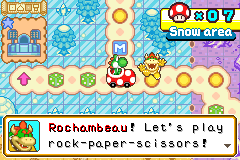
Unlike the main games which has a preset number of turns, turns are a limited resource in Mario Party Advance, and once you run out, it's game over. Because of this, the real challenge is how drawn-out a quest may be. Solving a quest can involve talking to a character first, hitting up specific locations, and then returning to the quest-giver. You have a limited number of rolls until game over, so the game's challenge comes from charting a smooth course, using the extra roll spaces to travel long distances.
Mini-game spaces reward you with more rolls for completing a game, and every few turns a mini-game is forced upon you anyway. It's a strange way of doing things, and it means the late-game challenges are just little more than pinballing across the board, hoping you solve your quest before you run out of rolls. There's no resuming from where you left off, you gotta do it all in order...!
The mini-games are adequate, but lack the creativity and chaos of the mainline games. You only fight opponents in duel mini-games, and the rest are simply single-player challenges against the clock or to beat the high score. To make games that lean slightly towards score attack is a smart choice for a single-player Mario Party... but it doesn't help that they're all a bit crap. The platforming ones are a novelty if just for being able to play as Peach or Yoshi, but you're missing out on half the fun by not facing off against multiple CPU opponents.
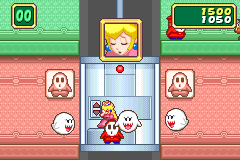
And honestly, the mini-games are the low point. The lack of engagement with them is what makes the game feel like such a slog at times. I might find myself invested in one of Shroomlock's investigations, requiring me to track down perps for questioning, but the journey to and fro is interrupted by mandatory mini-games breaks to earn more mushrooms. I figure there's a selection of 20 or so, but I find myself playing bloody Dreadmill more than I care to remember, and they get old real fast.
I think that change in design ethos is what makes the mini-games in particular feel like such tedium. You're fighting against the clock or the score, and they make zero effort to mix things up. Switch Way has only one level layout. Dreadmill never changes pattern. The duel mini-games are slightly more compelling if just for facing off against a CPU opponent, but in single-player mode they're only available in rarely-seen missions.
Even if you take the mini-games away, it's hard to describe what Mario Party Advance aspires to be. A busybody simulator...? You're not playing a game so much as going through motions. It almost feels like the sidequests in an RPG, and seeing all the quirky characters across the map is indeed reminiscent of Paper Mario or the like. Is it possible to make an RPG comprised only of sidequests...?
It sounds ridiculous, but honestly, there is a certain charm to the game once you get the ball rolling. To explore a simplified overworld and enjoy the various quirky townsfolk, going on silly little missions, it's the kind of thing you'd do as a breather between chapters in an RPG. To gussy it up with dice and mini-games and sell it as its own standalone product is... certainly one way of monetising the concept.
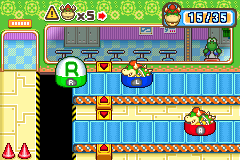
It's hard not to wish the mini-games weren't so dire, though. They work in the main games because they can make or break a player's progress: being deprived the coins needed to afford a game-changing item, or teaming up against someone who can earn a star if they make off with the winnings. That, and by virtue of competing against CPU or human players, the simple formulas always feel lively; you never know who's in it to win it or who just wants to be a pest. It's got baked-in chaos factor!
But in Mario Party Advance they're simply a formality -- pass this evaluation and we'll allow you to keep playing. They're no longer one piece in a layered system of parts that refuel the game's economy with money and vitriol.
And they're so stinkin' repetitive...! If the game were meant to be played in short sessions, I could understand, but when the game expects you to play in marathon sessions to fulfill a single quest, it knows you're going to be tired of these things just to cover the cost of traveling. Mini-games like Bob-oom were just too fiddly to even bother with; I'd sooner put the game down and let the clock run out than try to win. It's not even hard, I've just got better things to do.
And I mentioned they're dull, right? While it's cool to see mini-games designed on a 2D plane, they lack the variety and visual appeal of the 3D versions. I almost wish the game leaned into its rare 2D platforming elements, and instead made the mini-games into bite-sized platforming challenges. The game's already no stranger to homages and continuity, so why not?
Recreate some iconic setpieces like fighting Reznor or whoever, that kind of thing. Mix up the board game overworld with the micro-challenges you'd face in Super Mario Bros. 3. Find some way of spicing them up so the outcome had more reward or relevance to the board game; offer more mushrooms for good performance, find a way to make coins a thing. I don't know! It just stinks to have the mini-games feel so tacked on...!
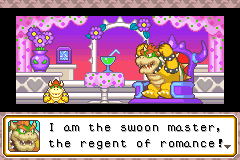
I was aware of the game's faults and foibles from the moment I started, and yet was reluctant to put it down. I wanna say it's an adequate chillout game; not quite the heartrate-spiking intensity of the console games, just something to switch your brain off and not-quite disassociate to.
The game barely escalates in difficulty or intensity; the very final Bowser challenge was barely any different than the rest, and the toughest one was easily the curling game, if just because of how long it takes; if you fail that's five minutes of your life wasted away!
The story mode is mere formality in most Mario Party games -- the real draw is the competition! So it stinks to realise once there's no more quests to do, all you're left with is dust bunnies and cobwebs. Completing a quest earns you a Gaddget, toys to play with that range from simplistic mini-games, to doodads intended to be played by sharing the GBA, or even toys in the most literal sense of the word, like lipsync machines.
It's cute, a counterpart to WarioWare in finding ways to treat the GBA as a depository of cute little tech demos that adolescents would get a kick out of... but in the grand scheme of things you rarely feel 'rewarded' for your 'work', because you're likely gonna try these Gaddgets once and never again.
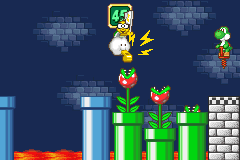
There's more features under Game Land to try out, but it seems like they just add mechanics on top of the same stable of mini-games. Duel Dash is notable if just for having the duel games in one place, even though half of them are trash. Mini-Game Attack pits all the mini-games together regardless of genre and ups the score requirements, making it the first time there's a whiff of risk involved.
Bowser Land is given a lot of pretense, but it's just an automated board game with only Bowser challenges at its disposal. These all award coins that can be spent on exclusive Gaddgets... all of which are posters or the trinkiest of trinkets, like access to the credits or a remix of the title screen music. Why bother?
Even after I finished the story mode I had a hard time putting the game down, hoping for something to surprise me and suddenly make me more invested in it. Learning the mini-games are tougher in Mini-Game Attack was almost a draw. Is it worth placing highscores in them? I don't know if I was actually invested in such a thing, or if I just had no idea what else to play. This has been a bad year for ill-conceived flights of fancy.
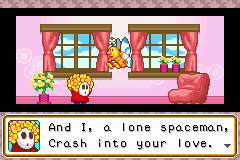
Again, I'll emphasise how fun it is observing the game's little world and characters. It's interesting that the citizens of Shroom City are almost exclusively tied to N64-era games; aside from Toadette and E. Gadd, I don't think there's anything hailing from contemporary GameCube releases! A strange oddity when, say, the Piantas were such an easy go-to crowd filler in Mario Kart and the like. It's all the more pleasing when a deep dive like Salvo the Slime shows up out of the blue.
But honestly, once the dialogue's all dried up, the game instantly loses a lot of luster. It's telling just how starved Mario fans believe themselves to be when in the face of multiple RPGs, multiple cartoons, a plethora of manga and comics, among other obtuse venues for story and dialogue, we'll still lap up whatever attempt at giving a Monty Mole personality we can get.
It's ultimately hard to recommend Mario Party Advance. It carves an interesting new niche for itself, but it can't shake the feeling that it's simply digital busywork. The presentation and dialogue is where it shines, with some humourous lines or the occasional hilarious scene; hats off to the localization team for nailing it with such limited text windows, too! But... you can probably just read the game script on GameFAQs if that's all you want, or YouTube, or whatever. The game itself is, at best, cute, and at worst... how many times can I say digital busywork?
Gatchaman Crowds: Insight
Aug 26 ~ Sep 04
Aug 26 ~ Sep 04
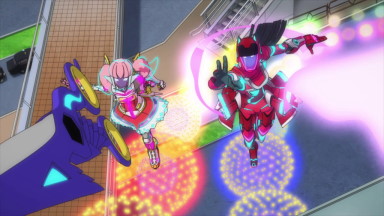
Back at it again! GALAX and CROWDS remain an everyday part of life in Japan, but the peace is disturbed by the rise of paramilitary "Red CROWDS" who commit anarchy to demonstrate the folly of human goodwill. What's more important, however, is the alien ambassador Gelsadra being welcomed to Earth and bringing with him his unique brand of peace and harmony, which is more disruptive than he personally believes.
Crowds ended in a curious position where it was hard to know what to expect from a sequel... and wow! This takes a very different tack, putting the characters all in very different circumstances than before. Hajime is tasked with mentoring the newest member, Tsubasa, an excitable teen girl just like herself with seemingly similar qualities, but a great heaping pile of contrasts, too.
Much like the first series, what kicks off with a very clear good-vs-evil is quickly subsided for something far more cerebral. In this case... politics! After the prime minister allows for greater freedom in elections through use of GALAX, Gelsadra ends up getting voted in through his infectious optimism and ability to play to the crowds by reading their emotions. He boasts a desire to please and generate goodwill that quickly turns into a cult of personality, and the Gatchaman are splintered as a result: Paiman tries running for office himself, while Tsubasa puts her utmost faith in Gelsadra, to the point of undermining the heroic ideals of the team.

Tsubasa is very much the viewpoint figure of this series, her life in sleepy Nagaoka turned on its head when she becomes the newest Gatchaman recruit, instantly thrust a buttload of responsibilities and into the public eye. On the surface she's a lot like Hajime, yet her similar sense of positivity masks a very binary view of the world around her.
For all her goodwill, she's a hypocrite and unable to view things any way but her owns until it's too late. It's easy to see her as a small-town girl blindsided by the three-hit combo of an alien landing in her backyard, becoming a Gatchaman, and being thrust into the public spotlight because of it.
She's quick to support the underdog in the heat of the moment, but fails to consider things from all viewpoints the way Hajime does. She creates a rift in the group because of her dual allegiance, seemingly more towards Gelsadra, and believes he alone should be responsible for solving everyone's problems, effectively putting the Gatchaman out of a job.
Policing how people should think, unwittingly or otherwise, is a running theme of Tsubasa's, from believing the CROWDS are a dangerous weapon, to acting instantly on her emotions and getting upset when told that's not always the best course of action. She makes a lot of foolhardy decisions throughout the series, and is arguably the instigator of a vicious chain of events that someone with more sense could've mitigated.
Although billed as the mentor, Hajime isn't the ever-present leader the role might suggest she is. A lot of her interactions simply hinge on others cottoning onto her cryptic musings. It's not her place to police how people act and think, and the freedom to create mistakes and learn from them is seemingly her way of doing things.
She's still a terrific character, and her sacrifice at the series' climax is incredible, a testament to her selfless spirit and faith in the community. Sadly, we so rarely see her interacting with the world at large; if she's not at base, she's seemingly wandering around town aimlessly. To see her bonding so closely to members of the community, be they kids in a daycare or old folks or whatever, is partially what makes her so endearing in the first season. She's the one who made the group go public! It's implied she's still at it, but she comes across as a more enigmatic character when she's so frequently off-screen.
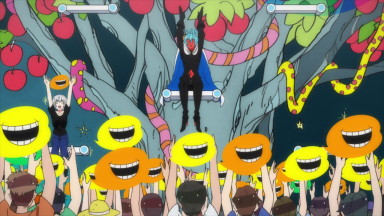
Likewise, the other members of the team fall into different roles. Sugane perhaps suffers the most, from serving as a key contrast to Hajime in the original to just kind of ineffectually going with the flow in this one. There's fun things like Paiman's daycare gig and OD's talk show appearances; Joe gets a pivotal role in aiding Gelsadra's rise to power, and instantly regrets it. Rui is now a key member of the team, and it's his fight for what he believes in that's a key part of the overarching themes; Tsubasa doesn't get it, and the entire climax is about hammering that point home to her.
Tsubasa and Gelsadra's arguments amount to trying to simplify the world, and as a social incompetent, I can relate -- having emotion icons above everyone's head would be a hell of a help guide. But the world's an interesting place because it's complex and disorderly. And to try and narrow it down into doing things that make everyone happy, and getting upset over the few people you can't appeal to, that's a sign you gotta log the heck off already.
After the first series offered so many surprises, this one doesn't slow down either, and goes so many directions I wasn't expecting over the course of its twelve episodes. Again, incredible themes and interesting characters; by virtue of Tsubasa and its ingrained themes of conflict, it wasn't as cheery a watch as the first one, and it didn't help its political themes hit a little close to home in this specific year. Immature cult of personality? Hinging your resignation on an idea you'd never expect to fly? It's all here, baby! It's rough seeing the world so splintered, and it takes some serious doing to penetrate Tsubasa and Gelsadra's pigheadedness.
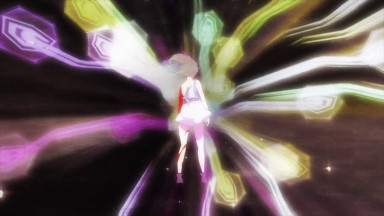
Again, I can see how even if the original won you over, this might put a strain on it. The specific themes of the original are switched out for an entirely new outlook, with the gang only as Gatchaman for short, relatively minor skirmishes. After Crowds ended on such a positive note, to see this put everyone through even worse straits is tough. Knowing it's not even malevolent alien influence, but simply weaponising mob mentality is a hard pill to swallow. It's depressing to see circumstances that totally sway the flow of the story, and to acknowledge very real shit in that vein that's happened in reality and passed with no change, but that's 2020, baby.
It's got an uneven reputation among the fanbase, but I was glad to see it; it's a very interesting sequel with some hella good themes, which is what you're here for if you're into Crowds, surely. The hard part now is coming to terms with the fact there's no more follow-up content, not even a manga...!
Mario vs. Donkey Kong
Game Boy Advance
Sep 21 ~ Sep 30
Sep 21 ~ Sep 30
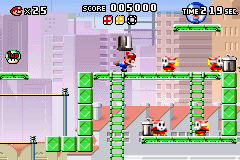
This is one of those games I've long tried to finish, but something about it always pushes me way. Donkey Kong on Game Boy is one of my all-time favourites -- it was my first ever game for the handheld! -- so it's hard not to draw the comparison to what it's clearly trying to build upon, the formula that the original did so flawlessly.
It's a puzzle platformer! Carry the key to the door while interacting with a variety of slowly-introduced mechanics, the most common of them colour-coded switches, which toggle the appropriately-hued objects on or off. Each level is divided into two screens, and every seventh level mixes things up by having you escort the Mini-Marios to the toy box, manipulating the environment via switches to aid their lack of jumping prowess. Clobber Donkey Kong at the end and you're onto the next world. Rinse and repeat!
I think what immediately upset me when I first played the game was how... strictly formula-driven it is. Donkey Kong GB obviously played by a stable ruleset, but something about its large levels and sheer variety of themes and hazards felt so invigorating. Turning the arcade gameplay on its head by launching you into a puzzle-platformer set the bar for how impressive it sought to be, and in short order you were pushing the platform-placing tools to their limit. I won't lie, it got ambitious so fast that it took me years to even get past the second world -- manipulating the bugs via closed doors among other things was a bit heady to wrap my head around! -- but the impression it made can't be topped. That's nostalgia, babe!
So Mario vs. Donkey Kong ditches the placing-platforms stuff with coloured switches, which is a lot easier to understand, but also far more tepid. Rather than having some control over how you solve the puzzle, you know how many times you'll be backtracking between switches at minimum. The game has holdovers from the original game like climbing vines, wielding hammers and swinging on tightropes... but they tend to feel a bit shoehorned in.
The hammers don't appear often enough to feel like a core feature, and swinging on ropes is such a drag; it takes too long and they don't give enough height to make them feel rewarding, y'know? However, I do respect the game simplifying things and trying to emphasise replay value. Each level is relatively bite-sized, and collecting all the presents and making quick time is key to beating the level's high score.

The game takes a serious uptick in difficulty come World 4, and it doesn't pull any punches. Stages demand you do a very precise sequence of switch-pressing and conveyor-toggling for things to play out as intended, and knowing the limits and idiosyncrasies of Mario's moveset is key.
The first level in World 6 demands you know the difference between letting go of a rope, jumping off a rope, and falling off a rope. They're all different! and falling off a rope (that is, holding a direction until Mario lets go that way) is necessary to reach the key. Letting go drops you straight down, and jumping will make you hit the ceiling and also plummet. That was an inexplicable and frustrating roadblock... and then once I learnt that knowledge, it's never expected from me again.
Levels get very large and very ambitious, often demanding you scout it out using the free-look command (L and R together!) to chart out a path. There's so many optional dangers just to hide a bonus present that you can safely avoid if you've no interest in them; the bonus games are lousy anyway. While it's satisfying to find shortcuts via use of the backflip or triple jump, at times it feels essential because something as simple as grabbing onto a rope without clonking against the ceiling can be so fiddly.
Boss battles are still in the classic vein of chucking barrels at DK's bonce; some are the kind of straightforward arcade action you want, while others feel lke they've been sourced from the worst fangames. The battles get progressively more puzzle-orientated, dealing damage via abstracted means, often with very little risk of the boss actually hurting you.
The penultimate boss is the worst offender, where all you're doing is toggling conveyor belts to push Bob-Ombs in DK's direction. The final fight is the closest the game gets to classic arcade Donkey Kong, with high scaffolding to scale as you carry barrels up with you. It's finally the kind of arcade action you want, as the bosses are otherwise a snooze, an obfuscated roadblock when all you want is a breather from puzzle nonsense.
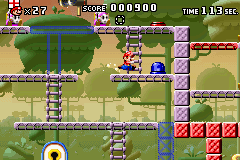
The sound design absolutely fucking blows, though. I honestly think that's why I always find myself so repulsed by the game. I don't think I had too many grievances with the added voices in the Super Mario Advance series, but every sound in this game is a digitised grunt, squeak or shout, always magnitudes louder than the music, and always disgusting to listen to.
All the noisy digitised voices, the twinkly plonky music, the obnoxious squeaks and squonks... it's all absolutely obnoxious. Having to listen to Donkey Kong's squeezing and groaning at the start of every stage or Mario's prolonged celebrations afterward is well and truly mind-numbing.
I've expressed grievances in the past with the game's graphics as well, commenting on how fuzzy and indistinct Mario is. I think my stance on it has slackened; if nothing else I do enjoy how well-animated everything is. Everything's got an unnecessary amount of animation frames, and for Mario and DK especially, there's a fun snap and flow to the way they move.
Mario's sadly not as malleable as he was in DKGB... yet the few times you do see him get pummeled into paste is strangely unsettling. He otherwise just falls down when hit by a lethal object, but the way it lingers on his flattened body for a needless amount of time is just unpleasant. Compare that to Super Mario Galaxy, which shows it just long enough to convey "don't stand under Thwomps you plonker" before throwing you back into the action. Here, getting Mario crushed is like it expects you to inform his next of kin.
The graphics have merit, but something about the game just feels so rote, with no room for variation or surprises. Every world's in the same order, with the boss stages an underwhelming break from the norm by the time they finally come around. with each stage split into two screens, levels tend to feel longer than they should be, and by the end when screens get particularly huge, you're practically dealing with two deadly challenges in a marathon. The likes of DKGB or even Super Mario Bros. 3 knew the merits of short, self-contained challenges, and the two-screen setup exists only to facilitate the score attack function, where time carried over from the first screen is what earns you mad points.
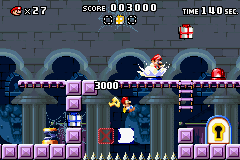
I had gotten seriously burnt out by the time I reached the last world, and the unchanging formula did nothing to alleviate that. The game's dedication to not surprising you in any way only makes the revelation there's another six worlds after the credits that bit more frustrating. I wanted to put this game behind me...!
But I'm glad I stuck with it, because suddenly the game has the spark of life again! World + is an extension of the Mini-Mario levels, the goal is now to escort the key-bearing toy to the exit door, using your usual repertoire to lead them there unharmed. The Mini-Mario can use springs but not ladders, and only scale heights that are 1 tile high or gaps 2 tiles wide. They instinctively follow Mario to his position whenever possible, so sometimes blocking their path until you're in the right place is key to prevent them from coming a cropper.
This mode ditches the tutorials before each stage, mostly because you should be acquainted with all the moves by now... but it's learning the ropes of Mini-Mario himself that's the struggling point. World 3 was a huge stumbling block when the toy refused to drop down a hole in favour of springing up to my position, and as far as I could tell the solution was to trap him inside a block... a feature I've never had to use before and seemed like an honest-to-goodness glitch. When the tutorials exposed me to the most brain-dead of tips and tricks, it would've been nice to know this was a feature and not a bug...!
Teething pains aside, this mode is suddenly a breath of fresh air after I'd run out of steam on the main quest. It helps that it feels arguably more streamlined than the base game, with better emphasis on player action, so to speak: rather than passively carrying a key around, the key is now a living object that's vulnerable and has a mind of its own, and learning how to lead it and protect it is, well, key. It effortlessly streamlines all the back-and-forth into something way more immediate and compelling.
That and it feels so much more arcadey. Some levels are shockingly short, and each stage is just a single screen, none of that double-length malarkey. Some are more thoughtful, requiring you to waste enemies and chart a path for both of you, while others are little more than gauntlets, running between hazards or outrunning rising lava. Levels are short and sweet, and by virtue of omitting the two-tiered time bonus, it's extra incentive to properly get good at racing through them to beat the score. Surviving an ordinary stage without dying, no matter how tardy, was usually enough to beat the default score.
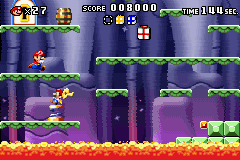
It's frustrating that this mode is locked off until you've beaten two thirds of the game (you'd think it's a half, but counting the double-length stages...!). It's so much more immediately engaging than the key stuff, and a more fresh approach on the formula that doesn't draw nearly as many comparisons to DKGB.
I can understand not wanting to bill it as a main feature, though: it's a mode all about escort missions, innit? The puzzle-platformer dynamic gives it an edge, but escorting vulnerable people through dangerous environments, no matter the context, tends to be a warning sign in video games. It's good though! It's a breath of fresh air! Take from me, notorious bad opinion haver!!!
While the main game was an exhausting affair where some days I only had the patience for a single stage, I breezed through all of World + in one afternoon. Occasional roadblocks and crummy revisited bosses aside, it mostly sticks the landing. The final boss is a rehash of DKGB's giant Donkey Kong; it kind of flubs some of the original's design choices, and it doesn't make the same impression as the original because nostalgia, natch, but nice to see it try.
Beating World + then unlocks Expert Mode, where your high-score stars are put to use by unlocking 12 more levels. I think I'm good. Maybe some other time. Kudos to the game for packing in so much content, but I'm done...!
It wasn't without a whole lot of frustration I could've done without, but it was nice to see the game through to the end. I do wonder if it were more adventurous in its formula and presentation, not afraid to mix up the goal between levels, it would've made a better impression. Hell, changing the soundscape would make a difference too. Knowing the game was American-made is a novelty; fair play to them for getting an entire franchise to themselves! It would've been nice to see another instalment reiterate on this instead of turning into a Lemmings clone, but seeing how burnt-out I got, perhaps that was a good turn. It gives the Mini-Marios more to do than simply be damels in distress, I suppose.
DKGB's such a great game it's unclear what you could really do to expand on it without just retreading old ground or adding arbitrary gimmicks. Fair play to them for trying; better to see something fresh than needlessly remake something that was already perfect. Good to experience one of my comparative blind spots in the Mario and Donkey Kong franchises, but it's only got me wishing DK had better games. This was a rough period for the big ape...!
Fire Emblem Awakening
Nintendo 3DS
Oct 21 ~ Nov 22 (modded)
Nov 24 ~ Jan 2021 (vanilla)
Oct 21 ~ Nov 22 (modded)
Nov 24 ~ Jan 2021 (vanilla)
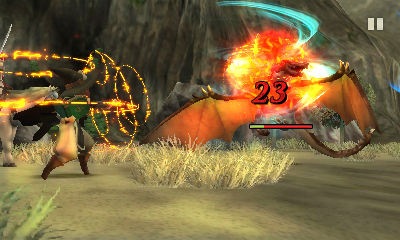
This came installed on my second-hand 3DS and I've never touched it all these years (i mean, why bother when Pokemon Rumble is RIGHT THERE???), but after finishing Persona 3 I wanted a smidge more RPG in my system... and since Dok was a fan of the series, it was something we could natter about as well.
So... the last strategy RPG I played was La Pucelle Tactics on PS2 for all of two levels, and I don't think Bomberman Wars counts so I guess that's the only one. It's nice to finally, properly play an SRPG, especially one that tries to get me invested in its story and characters and whatnot.
I tried playing on Normal difficulty at first, but switched to Hard after realising I wasn't getting my ass kicked for playing matchmaker with my troops rather than playing smart. Hard is tough, -- very tough, actually! -- but it forced me to actually pay attention and not just bumble headfirst into deadly situations every turn.
The early game is particularly tricky, with very few resources and so many weak units who can barely survive on their own. It's a tough haul, especially when strong units like Frederick and Chrom inevitably absorbed all the EXP that could've upgraded my lesser dudes. It eventually begins to even out down the line and you're able to build a force that isn't supported entirely by two beefy blade boys. Getting access to the overworld and daily random battles does help, but recruiting multiple mages to deal both long-range and close-range damage is when the tide truly turns.

I'll be frank, I never felt like I was playing the game properly on my first runthrough. Constantly getting bodied on the first turn, facing no repercussions for resetting and redoing a turn until the outcome favoured me... it did help me better understand the game, but it felt like I was doing it all wrong.
I'm told that's just Fire Emblem culture, but it felt rotten to go through the entire game basically scraping my way through. Dok rightfully called me out on my bad, stupid decisions (HOW WAS I SUPPOSED TO KNOW LUCK WAS A USELESS STAT???), but the fact I was able to finish the game at least meant I could make progress, be it by hamfisted means.
Replaying the game was a much smoother experience for the most part, now that I had hands-on experience with the mechanics and knew how they played out in full. Knowing how to utilise my weaker units in a more timely fashion allowed them to quickly power them up, without having to delicately line up kills for them; Lissa was all but unsalvageable on my first run, but on the second go-around was possibly the strongest unit in my roster! Knowing what's coming kind of negates the surprise, as you might expect, but it was nice to be able to plan accordingly and not just get walloped by unexpected reinforcements. I know I'm trying to grind, but gimme some space, man!
Beyond combat, the big thing on the side is Supports: pairing up your units to build relationships between them, which offers them better stat upgrades in combat, but also amusing dialogue scenes. These range from idle downtime in the barracks, to shared endeavours that blossom into quirky friendship, to outright kissy-wissy romance. Even after forty hours of playtime I was still learning better ways to build Support, but it's fun finding ways to make units work well with one another, and the dialogue is a fun reward for it.
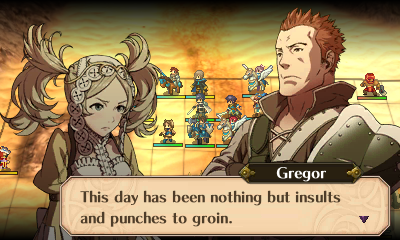
I wasn't expecting to find myself so invested in the game, but I think the format pushed all the right buttons. Once I knew the ropes it was easy to pick up and play, with the freedom to play for up to an hour or as little as five minutes, to breeze through a random battle or even just test out some moves on the first turn to see if they're viable or not. After Persona 3 being such a long sit-down sort of affair, it was nice to have something easier to dive in and out of, that catered to my needs for both meticulous fiddling and also thought-deprived auto-pilot.
I will say the game did a number on my perfectionism. It's a good thing I didn't learn how fusions worked in Persona 3 until the very end because I'm sure that would've triggered it too, but the need to see every battle go as smoothly as possible with no allies KO'd, it felt like a bad habit. If I had difficulty with a mission I'd struggle to think about anything else for the rest of the day.
The fact it's so easy to biff it in minor ways, like pairing up units in the wrong order so the weaker one is exposed during the enemy's turn... well, resetting and doing it perfectly just becomes too tempting. I think I finally broke the habit when I started a file on Lunatic difficulty and realised perfect turns were the only road to success, and that was boring as hell. Glad I broke out of that habit! Gimme a month and I'll be doing it again, I'm sure.
Fire Emblem Awakening's a good time. Again, not sure whether I'd be in a rush to try the other instalments -- the earlier ones look too stupidly difficult for a start. If I were to explore, I'd sooner see what other strategy RPGs bring to the table, but that all depends if this phase lasts or not. Very glad to have played the game, though! It occupied me for a good long while, scratched the itch of gameplay and storytelling, and I finally understand why people think so highly of all these sword boys in Smash. Put Sully in, though. That series needs more horse rep.
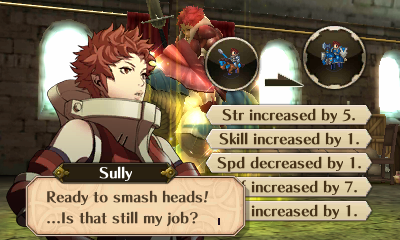
Gay Awakening mod: I used this mod during my first runthrough, which adds Supports for every character as well as the ability for anyone to marry anyone (within reason). I figured, why would I want less character interactions in my game?
I won't lie that installing this before I'd even touched the base game was perhaps a bit daft, as I had no idea what was actually new. I'd be discussing Supports with Dok and he'd tell me "those characters don't have Supports with Chrom." What's official and what's not? I've no idea! This is a bad way to judge a game's writing!
While the mod intends to give every character interactions with one another... well, that's certainly the intention. Their support rank and paired stats will increase, they can marry and sire children, but very few pairings have any dialogue implemented. You can make Miriam and Tharja hang out as much as you want -- make them have kids, even! -- and they'll still have nothing to say to each other. Which might be in-character, who knows, but it stinks when you're hoping for fun new interactions.
Dok uninstalled the patch because of it, and I should probably have done the same because it obfuscated the entire Support system for me. Everyone has slots on their Support list, but there's no indicator if the dialogue is implemented or not, turning the game into a crapshoot quest for content. I want conversations, but which characters will converse with each other? It's a mystery!
Hell, it's possible this gave me a dodgy complex about the game's whole method of storytelling. I have trouble connecting to medieval settings at the best of times, but if you're not a bandit or a member of Chrom's crew, you're doomed to be a poor widdle villager who exists solely to hand out items when rescued or get killed for dramatic tension.
The plot hammers in its ideals of peace and harmony between kingdoms, where there are rightful tiffs between Ylisse and Plegia that could be addressed... but for all their optimism, the heroes would rather refer to them as racial slurs and the villains just stoke the fires of discontent to help resurrect a dragon or whatever. You'd like to think there should be answers to these problems, but if it ain't violence, nobody wants to hear 'em!
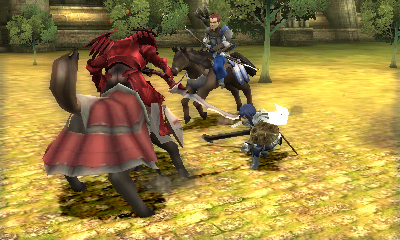
Between that and the Supports where you see the funny, charming, heartfelt side to your units... it kind of sucks that your only means of engaging with the world is by killing the fuck out of people. If you want to see your units interact with one another, you better start making them murder in pairs*. And if you want to enjoy your off-time between missions... well, I guess you can go visit the shops and sort your inventory, or summon some Risen to massacre.
* (i know, you can build bonds by using healing staffs as well. but if you can't use staffs, get to murderin'!)
This is no doubt whiplash from having played Persona 3 previously, which had more controlled downtime in general. If you wanna hang out with a dude, you just spend an afternoon with them. If you wanna acknowledge the world you're trying to protect, all you gotta do is leave the dorm.
In Fire Emblem, for all the talk of the kingdom you're fighting for, you barely freakin' see it. Understandable, given you're playing as a bunch of royals, but I dunno, the mesh between relentless bloodbath and cutesy vignettes... just didn't sit well with me. If I could, I'd beeline straight for the boss so all the grunts could surrender peacefully, but then I wouldn't be getting any experience, would I?!
I played it long before I started smelling my own farts regarding stories in video games, but I didn't have this beef with La Pucelle. From what little I played of that game (two levels, I remind you, just in case this argument weren't stupid enough), it had a dopey, irreverent vibe to its story and characters, very much in the Slayers vein of wacky comedy antics.
Violence is the language of the combat game, and in that instance it felt like an extension of its built-in slapstick. But when Awakening alludes to how dour the state of the world is and gives no alternative to slaughtering every desperate bandit I encounter, it all hits a little differently.
This totally came about from being starved of content, mind. Simply not knowing which Supports had working conversations, offering no distractions between the long campaigns of wanton death, had me focusing way too much on this juxtaposition that I didn't notice nearly as much on my second go-around without the mod; once I was getting rightfully rewarded for letting units hang out I had far less beef with all the murder.
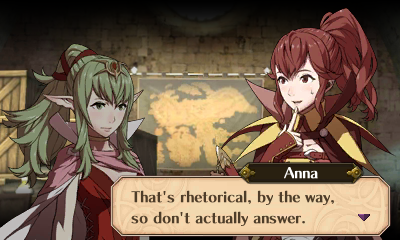
In the end I'm not sure how many Supports I even pursued in the modded playthrough. Chrom and Lon'qu got married kind of accidentally, resulting in Lon'qu having an inferiority complex over Lucina being miles better than him, and also quoting memes.
I didn't see it to the end, but the Chrom and Gregor Support was shockingly good, earnest and well-written, offering great insight into both of their attitudes... making it all the more of a surprise when I only found out later it wasn't in the base game. Good show!
As a community effort, most of the supports have already been written, you just have to scour the author's Tumblr (and Google Drive, and Pastebin, and Dropbox...) to read them all... at which point you might as well just treat them like fanfic since the mod's still got a long way to go. The effort's appreciated, and it's no doubt for veteran players eager to see something new; to play it right off the bat gave me a wonky first impression of the entire game. I probably wouldn't recommend it until it's more fleshed out, and seeing how it hasn't seen an update in over a year, who knows if that'll happen?
Super Mario Bros. 3
Super Nintendo
Oct 23 ~ Oct 24
Oct 23 ~ Oct 24

After taking all this time to beat Persona 3, I needed something simple to unwind with!
My brother uses "what's the best Mario game?" as a quick and easy topic of debate among his friends, and while the internet makes such arbitrary ranking seem tiresome, with people you know it's a fun way of seeing their experiences with it. He still holds Super Mario World as number one. It's the one we grew up with, it's so easy to pick up and play, so much to see and do, it's got Yoshi in it...
Yet for whatever reason, I have more memories of Super Mario Bros. 3, and I credit that to how finely tuned it feels for 2-player. Taking turns tackling levels, even pursuing different routes if one is too hard, adds a vague sense of control and exploration to what are otherwise linear maps. That, and being able to fight each over 1Up cards in Mario Bros. arcade battles! What a nifty little feature, huh?
(arguably Super Mario World has an even bigger potential for exploring, given its massive sprawling overworld... but i can't remember the last time we actually started a new file so we'd just pick and choose our favourite levels. different strokes!)
The game's still good after all these years, natch, though it kind of loses something playing on my own -- it might be because I'm not squabbling over cards, though I probably just miss the banter. The game plays smooth, and there's a healthy sense of weight and momentum to Mario -- even with the powerful Tanooki suit and raccoon tail, you still can't ignore basic jumping protocol. If you miss that platform by a few pixels, you're sunk!
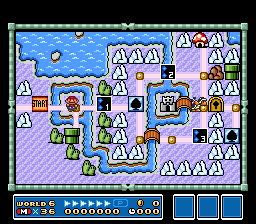
I spent more time focusing on the art design than anything for some reason. I've watched a lot of let's plays and challenge runs on the original NES version, while I stuck with Super Mario All-Stars. The games on that collection went through a variety of little changes, and I think it's unanimous that SMB3 saw the least edits. Sprites got colour, new backgrounds were added, the battle game was made less shit looking... that's it, really?
The new backgrounds are nice, though having seen the original it feels like they take away from the atmosphere at times. The original used colours in creative and attractive ways, with airships coming in blue, green and turquoise, but the remake is a bit more utilitarian about it.
It doesn't help that by virtue of SMB3's multi-scrolling levels, it was probably harder to implement certain changes -- water levels are depicted using a translucent layer for everything beneath the waves... but all other stages just use the regular bright blue tiles, which look a tad strange, especially in the ice world's cave stages where it's just an entire screen of one flat shade of blue. Just a limitation of background layers!
I dig the game's love of secrets. All the warp whistles to find, the treasure ships -- this was my first time ever finding the secret off-screen area in world 2 myself! Peach's cryptic letters are about the most hints you got if you weren't reading Nintendo Power. I think Super Mario Advance 4 did a better job of revealing some of them, like adding a "total coins" counter to the stages that unlock treasure ships? They're part and parcel with the franchise, but I do like how much these games leaned on secrets.

World 8 gets properly tough, and its fortress stage was the first to well and truly test my patience. Being able to save in All-Stars is a blessing, as I beat the game in three sittings and wouldn't have wanted to leave the power on (or make savestates, hurf). The game's good about making it easy to catch up even if you have to restart from world 1; there's two warp whistles within the first four stages, and the dynamic of beating fortresses to unlock shortcuts is really nifty, if a bit of a hurdle in 2-player. Oi, now I have to beat your stages because you died on me!
Mario 3's good. It was nice to play the game again. Having so many tools at your disposal is nifty; I started from a fresh file and had so much stuff just through casual play and no game overs. Being able to skip levels with the cloud if you wish, or flying over an entire stage with the P-Wing, it's got so many optional concessions to make things easier or even give yourself a harder time... I wanna do a full frog suit run one of these days. I don't think the internet needs another dozen paragraphs to sing the praises of SMB3, but darn it, it's nice to affirm it's a neat game.
Night in the Woods
PC (itch.io)
Nov 02 ~ Nov 07
Nov 02 ~ Nov 07
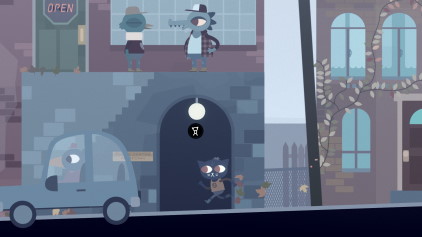
This is one of those cult indie hits people were hype about on the Twitters when it came out, but I could never actually decipher what it was meant to be. Is it a 2D platformer? Is it supernatural? Is it a murder mystery? Crimes are a thing, it seems. I sincerely had no idea.
College dropout Mae returns to her hometown, catches up with old friends, and basically lives the slacker life, with all the highs and lows that come with it. This manifests in roaming around town, checking out the sights, catching up with friends and meeting up for hangouts, band practise, or crimes.
It's not exactly a 'gameplay' game, per se. There's platforming, but it's more just a vehicle for exploration, hopping along window ledges to reach out-of-the-way points of interest. Taking control of Mae is simply a means of choosing what you interact with and where you stop to sightsee. Although band practise does require some degree of hand-eye coordination, the game doesn't end just because you're crap at bass. The closest it comes to 'gameplay' are Mae's dreams, where you have to light up torches and find ghostly musicians before returning to a vigil to 'complete' the dream.
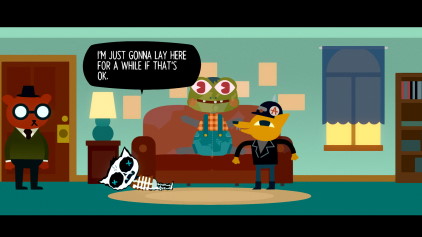
By virtue of being a story or interaction-driven game, you want to be doing things, and so checking out each hot spot on each new day just felt natural, and seemed right in line with Mae's compulsiveness. To tell the story this way, with the player in control of Mae's choices, feels appropriate. Everything you do in your off-time feels in line with her impulsive notions, but you're unable to truly curb her bad decisions; if she's in the mood to steal something, you've no choice but to complete the petty theft mini-game!
You never impose your decisions upon the character, you simply choose which of her thoughts to act upon, so to speak. You can phrase things differently, but she's still going to be rife with self-loathing, or a messy drunk, or an unhelpful friend, or any number of self-destructive traits.
It hurts to feel powerless in such situations, where you've no choice but to make a sloshed, vomiting mess of yourself at the party, or say foolish things and have Bea blow up at you. Sometimes you never know bad stuff has gone down until you're in the thick of it, and you're unprepared to react accordingly, which is painfully true to life. If you were playing as a master tactician such scenes would feel hamfisted, but as a jobless self-loathing bum who's bad at socialising, it's pretty appropriate. (and very hashtag relatable)

The dialogue's got a fun ebb and flow to it. It's the kind of gormless and awkward idle banter you'd expect from teens, but it's very entertaining and often very real, with characters rightfully calling out the flaws in themselves, in others, in the world we live in... but rarely do we have the power to do anything about it. There's also a whole lotta insight relating to small time life that I'm sure is hella relatable to the types of towns it evokes. I'm probably too close to home for it to really hit the mark. Been livin' in the same square mile my whole dumb life!
Honestly, the game's structure is strangely compelling, breaking itself up into little mini-quests, with a familiar trapping of running through town and stopping by the usual sights. It's an interesting way of engaging with mental illness or even executive dysfunction in a low-key way: Mae can't hold down a job and is a mess in no shortage of ways, but getting out of bed to fart around town comes easily to her and the player, because you wanna do stuff! You wanna engage with the folk, you wanna bounce around on telegraph poles and whatnot. Big mad lad energy.

The story's presented pretty leisurely for the first few chapters, with enough unease and intrigue to keep you going. There's a mystery afoot, but there's enough personal drama with your friends, your family, and the town itself that seems higher priority than chasing ghosts.
By the final chapter things get a bit far-out, with the small town life stuff dropped quite abruptly in favour of a vagrant-sacrificing death cult, thinking feeding a hole in a cave will make the town prosperous again. Mae has bad dreams and visions relating to a strange god-like figure, and it's implied the two are connected... but it could just as easily be Mae going through a psychotic episode. The mystery's wrapped up somewhat explosively, and it's ambiguous what ripples it will make or what Mae's dreams were all about... but it's not their place to figure it out. All they can do is keep on living.
It goes a bit wild towards the end, but on the whole, a game I was thoroughly engaged in! It was nice to get invested in its characters and the small sliver of world you see, and I can imagine it becoming the type of game I'd replay as comfort food just to see what I missed or revisit my favourite scenes. It gets raw and messy and heartfelt... which probably isn't the kind of experience people ask for in their $15 video game, but personally, it was nice to play something that felt so earnest.
Persona 3: The Movie #1: Spring of Birth
Nov 06
Nov 06
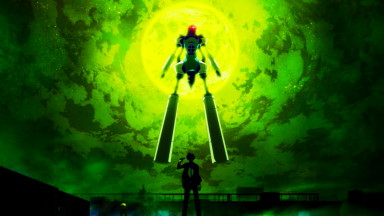
Watched this with Dok on a night when we had nothing better to do, the first of four movies animating the events of the game; this covers up to Fuuka joining the team.
First of all, it's a really swish production. The animation is smooth and lush, the colour palette is on point, and the characters are all rendered very nicely. I say this because I honestly wasn't a fan of the cutscenes in Persona 3 FES? The action scenes were adequate, but the characters themselves just looked noodly and off-model at the best of times, and the way it rendered faces never sat well with me.
It ruffled my feathers imagining the money they spent on something that felt limp and at odds with the in-game graphics -- just use the portraits! They're nicer than these dodgy animation models! The Answer then showed where the budget really went, as its cutscenes were boffo, but I digress. The film looks good! If you want nice animation, here's where you look!
Unfortunately, adapting the storyline of an RPG into a serialised medium is apparently a sticking point of mine, be it a televised anime or across multiple movies. Not to sound like I know what I'm talking about when I've only played one flippin' game, but the impression I got from it was that you, the player, guide the journey.
There's still a main story to unfold, but how you balance dungeon runs or hanging out with your buds or other activities is in your hands, and ideally no two playthroughs should be the same... if it weren't for people following optimised routes because they don't want to miss anything, but I digress. Again.

So the fact the film (and what little I saw of the Persona 4 anime) just kind of blazes through the main plot points without really stopping to smell the roses just felt... bleh.
To be fair, I think the fact this is the first video game movie I've seen that's actually a straight adaptation is jarring.
I'm so used to them telling a brand new story, either through "greatest hits" artistic license or plain ol' bastardisation. The Street Fighter II animated movie made up its plot wholecloth, and I think you'd be hard-pressed to say the story was very Street Fighter in tone, but it's got cool fights and fanservice so it covers the bases...!
I'll concede that cramming an 80 hour game into six and a half hours across four movies is decent going, but I couldn't help but feel like... what's the endgame? How much of this is aspiring to be an actual movie that can stand on its own two feet, rather than an animation designed for hardcore fans to gush about amongst themselves? How much of this story actually befits the film medium's standards of storytelling rather than simply aiming to be game-accurate?
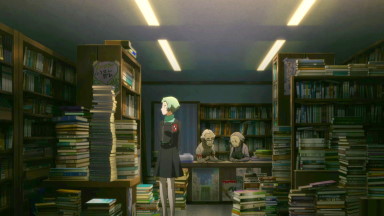
Again, to condense 80 hours of game time would be wild, but the way it adheres to conventions of the game's presentation, like showing the passing of time via the in-game calendar, only served to annoy me. Don't show me that! Film already has a way of conveying the passing of time through something as simple as a cut or a fade between scenes, and to go against that in the name of borrowing visual cues from the game just bugged me! The one time it finally came into use was during the exam montage...
... and even then, the story is so straight-to-the-point that the context of these exams is lost. The gang are students who find time to fight monsters. Very little is said of their time at school, nor does Mitsuru urge them not to forget their studies. There's omissions for the sake of story flow, and then there's changes that just seem to be weird and fussy, like the gang's encounter with Shinjiro visiting Akihiko in hospital... who's only in for a routine checkup, instead of recuperating from his injury during the first shadow attack. Are checkups that much cause for concern? It's a strange change that only makes the characters visit to the hospital that more inexplicable! Just rewrite the scene!

Again, I'm probably viewing it from the wrong perspective. I assume the film is expressly made for fans, to animate sick-ass battles and highlight iconic moments between characters. I was probably hoping for something distilled the story in a more meaningful way, not just cutting out the bumph between monthly missions.
While the full moon and passing of time is thematic for the shadows and whatnot, is there a way to distill the year-spanning story into something that could fit a typical full-length running time? If you were to distill Persona 3 into 150 minutes tops, what would you prioritise and make the crux of the story? Or is that a stupid endeavour and all Persona storylines must be a ten-hour minimum? I'm bastardising this, aren't I?
It was a fair enough watch, that's about the best I can say. I think I just disagree with adaptations of Persona on a fundamental level. To play a game with choices inherently builds some kind of relationship between the work and the player, and to then ditch that for a prefab outline where all the optional flourish is tossed out... I don't know. Make it an anthology, insert new vignettes, do something to make it a unique expression! Don't just replay it on fast-forward!
I might've had a point in here somewhere, but it's gone now. If you figure out what it is then please don't tell me because it's probably stupid.
Crash Bash
PlayStation
Nov 08 ~ unfinished
Nov 08 ~ unfinished
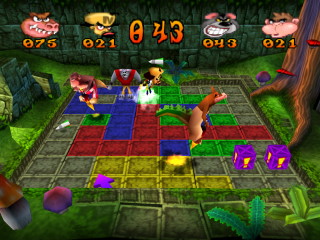
So, like, I enjoy the Crash Bandicoot games, but I'm not sure if I've ever gotten all in as a fan, y'know? There's some franchises where I lose a lotta time thinking about the world and the characters and all that sappy stuff. I might not actively think it, but after someone indulges me I'll realise I've got some hella opinions on the Mega Man universe that I'm guaranteed to forget until someone reminds me of my argument about what Reploid body dysphoria must be like.
I've never quite gotten Crash. It's a cartoon world where slapstick and comic pratfalls reign king... but there's also fans who are super duper invested in its fictional universe and how the several dozen villains all interact with one another. Folks with all kinds of opinions about N. Brio, a character whose existence honestly feels like a mass hallucination at times, and a real wet noodle compared to the visually compelling N. Gin. (if you haven't got a nuke embedded in your head don't fucking talk to me)
There's folks super invested in the trophy girls from Crash Team Racing, doubly so now that they're actual characters and not just an outlet to deposit for horny energy from the Naughty Dog artists. I love browsing the feeds of these super fans because while I don't know if I'm capable of sharing their sheer love they have for this fictional universe, I love to soak it in. Fandom can be good, y'all.
I say this because a party game where you play as the extended Crash Bandicoot cast sounds neat, but boy, even as a young'un, this kind of blowed. A mini-game collection framed like the traditional games' hub screens -- beat the five challenges to unlock the boss battle, then repeat on the next world.
Just from half an hour of play I was tired already. Some of the mini-games are decent, given more depth than most Mario Party events. Every game has power-ups of some kind and usually some degree of strategy. The tank battle allows you to move and aim separately, as well as ricochet bullets off walls, in addition to laying mines that can wipe out an enemy's whole health bar if they're unlucky.

The tile-painting game is pandemonium, but has an entertaining metagame of when and where to 'cash in' your points. You can be a pest in so many ways by painting over enemy tiles, or even hogging the crates to deny anyone else the chance of cashing in -- an enemy can have nearly a hundred points but they won't matter unless they're cashed! The mini-games can be very entertaining at times, even playing alone.
The problem is, because the mini-games are the game -- this isn't a layer on top of a board game or anything -- it becomes incredibly drawn-out. Rather than quick 30 to 60 second matches, the time limit is a minute and a half by default, if not outright endless, and you gotta win three matches to score the win! What begins as "oh, this is novel and interesting!" immediately becomes "oh god, there's more of this." And if you do lose, you can't even exit out and try another game -- it restarts endlessly until you win the game or reset the console. Good grief!
I think after Mario Party Advance, I've got it in my head hat every party game based on an established game franchise needs something that harkens to its classic gameplay. Even the first Mario Party had a few self-contained run-and-jump mini-games faintly reminiscent of the Mario 64 moveset.
Crash would be ideal, right...? Take the side-scrolling bonus stages and just make it split-screen, I don't know. The closest it gets is the crate-bash levels, wherein you walk around and chuck crates at people. For the longest time this was the best you got if you wanted to play as Tiny or Dingodile or any of these otherwise unplayable boss characters, outside of the racing games.
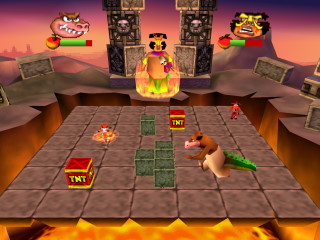
Speaking of boss characters, it's a strange cast...! It's too early days for there to be more good guys that aren't talking masks or quadropedal animals, so Dingodile and Tiny are partnered up with Crash and Coco. N. Brio is there alongside Cortex despite having only a bit role in Crash 2, alongside Koala Kong (last seen in Crash 1) and... Rilla Roo, a brand new character who's essentially the game's Waluigi.
It results in a cast that's half composed of big buff animal dudes. Which, to be fair, is probably the appeal of Crash's rogue's gallery, but it just seems strangely skewed. Was it done to simplify their movesets? I assume it's easier for everyone to do a spin attack when they've giant arms or tails to swing. You'd think Pinstripe would've been a more interesting representative from Crash 1 given Tiny's already the go-to musclehead, and literally anyone could've filled in for Rilla Roo. Give the Komodo brothers some love!
The game's a curiosity, I guess, and our first glimpse at how wishy-washy the series would become under other developers. There might be some fun to be had in playing this with friends, who knows, but the game makes an extremely blah first impression, and there's nothing to suggest it'll get any better.
Macbat 64
PC (Steam)
Nov 14
Nov 14
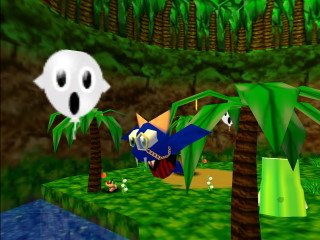
RQ87 got this and a bunch of other Steam games for my birthday! Ta, chum! I then proceeded to forget his birthday until, like, weeks afterward, just in case you need to know what kind of friend I am. Apologies...!
A cheap and cheeky little Banjo-Kazooie homage, an extremely bite-sized little game with only ten areas, most of them about the size of the ground floor of Peach's castle in Mario 64.
It's extremely compact, so much so that your only active action is the ability to jump and fly. All tasks are performed by walking into things or by some degree of fetch quest, be it gathering balloons to lift a deck chair into the air, or spawning a blowpipe so you can burst an uppity octopus. After everything from Mario to Banjo to Yooka Laylee had some factor of tacked-on combat, it's nice to see the game treat simply exploring and interacting as its main impetus.

Levels are extremely tiny (have i made that point clear by now?) and amount to a chain of events that lead to the level's key being presented to you. The jungle has an entire puzzle dungeon underneath it, while others like the beach are just teeny tiny little environments.
They're very cute and true to the N64 vibe, fuzzy lo-rez textures and all, and it even has some direct homages to N64 ilk, among them the Zelda-flavoured forest (complete with homage to Ocarina of Time's quest for the sword and shield), a "strangely familiar forest" that's definitely shades of Jungle Japes and Mumbo's Mountain, as well as a world that's just a very simplistic kart racing homage. Cute is the word.
The hardest it got was finding the last bolt in the watery factory, given its scope -- it was in the tail of the skeletal fish. There's four secret totems to find and apparently a bonus level or two, but I haven't been able to unlock them for some reason. It's by no means a long-lasting game, but for its dirt-cheap price it's a cute enough distraction.
Red Dwarf Smegazine
Nov 19 ~ Dec 06
Nov 19 ~ Dec 06
After watching series XI, XII and The Promised Land this year, I'm running out of Red Dwarf content! All I have left is to scrounge for DVD extras I haven't watched yet, if any! Crumbs!
While I approached it just for the comics, the Red Dwarf Smegazine is a veritable grab-bag of stuff: primarily news and interviews, behind-the-scenes featurettes, character bios and lore dumps, as well as silly questionnaires and prose. The comics are just a fun extra to what was probably the main attraction at the time -- getting news on the upcoming shows, merch, and other doodads. The early issues are a bit naff and take a while to find their footing, but on the whole it's a decent read. Very much for hardcore Dwarfers, though; even I zoned out on a lot of pages.

The comics can arguably be split into four categories: recaps, alternate universes, spin-offs, and just regular old adventures. The recaps were short lived; the first eight issues presented comic adaptations of episodes from series 1, The End and Future Echoes. Since they had yet to re-air or see release on home video yet, it was likely an exciting way to experience these stories that set the foundations for the entire premise, but were a bit stodgy compared to contemporary eps.
Alan Burrows does art on The End, with a fantastic ethereal palette and a great scope for the cold, industrial feel of the Red Dwarf ship. His human figures are rendered well, but his brand of samey faces are always a little unsettling; it improves as it goes on, but Rimmer always looks like a Thunderbirds puppet for some reason. It's an adequate retelling, but the presentation's all just a bit flat. Burrows is an amazing artist, but even he can only do so much to spice up a story that's nothing but people talking in hallways.
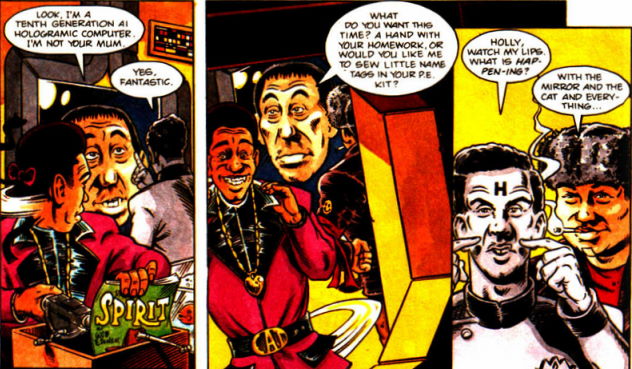
The next five issues then recap Future Echoes, and John Rushby is immediately much more suited to the role. His art is a lot more characterful with a better comic sensibility about it -- how to transfer the gags to static pictures, to spice up a page with dynamic panels and fun details. The third part has Cat hauling his wardrobe from out of a tube train, a fun visual way of showing the ship's facilities without needing to stop and explain it all.
It's still a straightforward recap, but it's fun to reread it -- it probably doesn't help I've seen The End a million times and it's a bit of a duff episode anyway. Rushby's art adds so much flavour to the affair; seeing stuff like Lister's conversation with the future Rimmer play out using similar panel structures and expressions repeated both times is a really cute way of portraying it without the ease of just replaying a repeat performance.
The Smegazine revels in its alternate universe stuff. Ace Rimmer's jaunts through parallel dimensions are chronologued, many of them parodies of comic fare like Superman or Roy of the Rovers, where Ace helps his other self out of a jam. It's all very rote, and too strapped for pagespace to do more than go through the motions.
The very first one is perhaps the most interesting, if just because it comes across more like fanwank than a cohesive story. After a jaunt into a fantasy realm to rescue princess Holly, Ace then revisits the universe from series 2's finale and beds Deb Lister. It's neat to see that crew again and how things have changed; they've since recruited a female mechanoid, Daizee, who serves as the caretaker of Lister's adolescent kids.
I'm hard-pressed to say any of it was actually funny or interesting; the gag just seemed to be Arlene Rimmer calling him a slag and that Ace might be pregnant. It would've been nice to see that universe explored in more meaningful ways; what's life like with the two sons on board? None of them are qualified parents, surely? It's the kind of story that served only to scratch a "what if?" itch, and to give Alan Burrows a short but lush fantasy vignette to sink his teeth into.
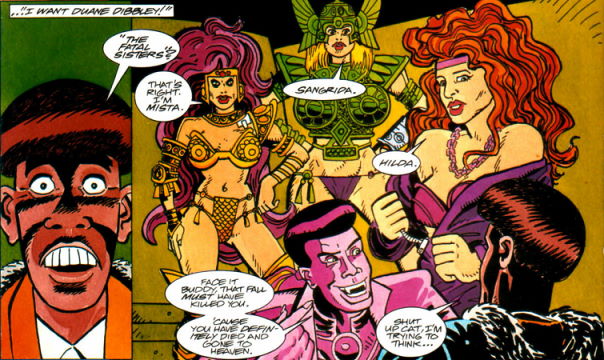
Jake Bullet and Duane Dibbley, Kryten and Cat's identities from Back To Reality, get their own ongoing series, having survived their apparent suicides and left to pick up the pieces. Jake's noir stories are handled by Carl Flint in a distinctive, photo-caricatured style, big on internal narration and far-out technology turning a corrupt city into an outlandish hellscape.
Duane, meanwhile, is stuck in an asylum for four years and is haunted by a visage of the Cat, eager to prove this world is a lie and to get back home; Nigel Kitching's kooky art style fits it wonderfully, with the hopeless dweeb getting into inexplicable japes.
Jake's first case wraps up neatly, but his second ends on a cliffhanger as he's arrested by his own chief, while Duane's quest is left unresolved, with only allusions to his alleged life before entering the video game. They're amusing rides, but require a fair bit of patience (or indifference) to parse, what with their chaotic artwork and love for infodumping.
Spin-offs are another kettle of fish. Mr. Flibble, Rimmer's penguin puppet from Quarantine, gets reimagined as a lecherous, murderous force of nature who exists to corrupt and blow up twee children's book settings. Rob Sharp's art in Young Flibble is a lot of fun, but it's just an outlet for the shock value sex and violence. Androids is an intentionally convoluted soap opera that quickly escalates with more and more indecipherable plot twists. I clocked out by the second strip.

David Lyttleton illustrates a few strips set on the outer reaches of the Red Dwarf universe, all of which build on cues from the novels, interestingly. Gelfworld focuses on the books' depiction of GELFs as literal genetically-engineered objects -- living furniture and appliances -- while The Aftering takes place on the cockroach-infested Earth elderly Lister is trapped on by the end of Better Than Life. They're largely excuses for Lyttleton to go ham with ugly, monstrous creations hurling abuse at one another, the stories unanimously ending in the planet dying by some means, taking its inhabitants with it.
They're about the closest the spin-offs get to truly exploring the world beyond Red Dwarf, and admittedly raise the question of whether you'd even want to see that. Viewed through the context of our heroes, lonely lives like that of Camille and Legion at least have an arc to tell, a lesson to learn. Without the lads to act as our guide, we're just blithely following some poor schmucks who live and die in relative pointlessness. It really is cold outside, huh.
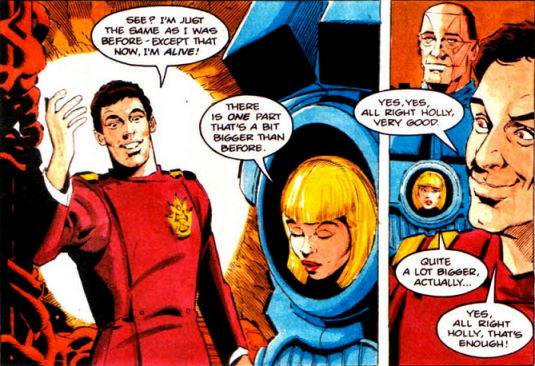
So it's a good thing there's real stories set in the regular Red Dwarf setting! They run the gamut from simple yuks to tired sci-fi tropes to somewhat heady fare, using the comic medium to get way more far-out than the TV show is capable of.
Wetworks (vol 1 issue 11) is perhaps the height of shooting for the stars, with a bizarre metaphysical tale of Lister getting converted into computer data, forcing Holly to go in after him and learn what it's like to have a body and interact with fellow human-like beings. There's certainly an idea in there, and any excuse to utilise Holly in a creative fashion is always worth appreciating, but between the abstract art and the dodgy focus it's perhaps a bit heady for Dwarf.
Volume 2 issue 5 has an interesting one-off involving trying to project Lister's mind back in time to try and prevent the disaster from occurring, but he ends up adrift in time, reliving the most stressful moments of his life. It offers a glimpse of the events between series 2 and 3, Lister going into labour while in the middle of repairing Kryten, and ends with another allusion to him being god, a hook that cropped up in the books but never got explored much.
It's kind of wishy-washy on what to take away from it; what's the endgame from saving the ship? Are Kryten and Cat really that self-sacrificing just to get Lister and Rimmer back home? And yet it's nice to see this kind of pontifical stuff when the show had gotten so comedy-driven. To explore the mythos a little more, even if it's just glimpses into Holly's transition or Lister's birthing process; the faintest whiff of ruminating on past events is nice. It helps it's another great showcase from Alan Burrows, who knocks it out of the park on these types of stories.
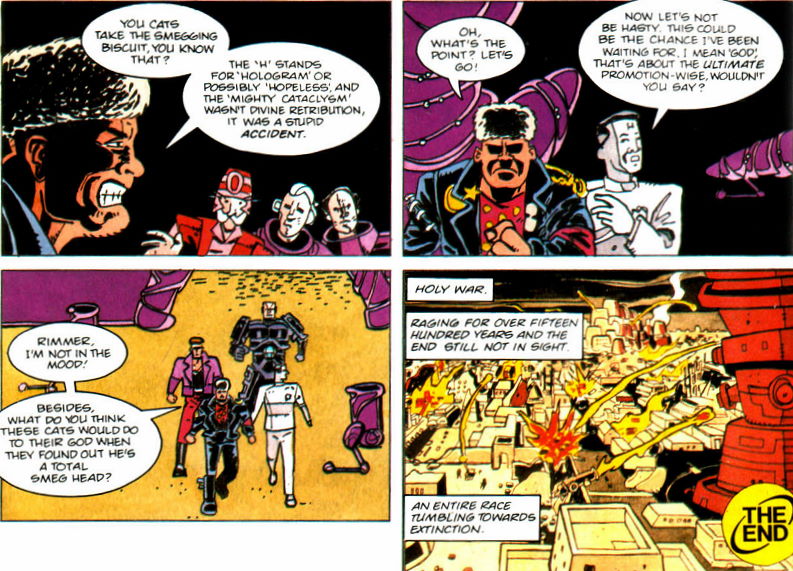
Speaking of Lister's godhood, the first three issues of volume 2 feature a story arc by Nigel Kitching wherein Lister is time-napped by cats so he can finally put an end to their holy war. It's a lot of fun and especially comic book-y, an adventure that truly fits the format with bombastic setpieces and visuals, including Kryten and Cat mowing down baddies with bazookoids. It's a bit too gung-ho for Dwarf, perhaps, but it's nice to see a story that just lets loose like this.
It plays around with the history of the cat race, the one tribe who dared to explore outside the ship, even interacting with Holly by hacking into the mainframe, their prophecies regarding "The Holy" and his non-corporeal 'offspring'... it packs in a lot of fun ideas into its pagecount. It ends pretty bleakly with no decisive outcome -- Lister acknowledges he can't sway their actions; they're still too rooted in their own squabbles and vendettas for the word of god to change their ways.
The first series was no stranger to the pointlessness of the holy wars and the self-destruction it caused, but to see it visually depicted, with blood and betrayal and a burning city beneath them, gives it a very different edge. Like I said, a bit out of sorts from usual Dwarf, but a great three-parter with a terrific mix of comedy, action and inferred melancholy.
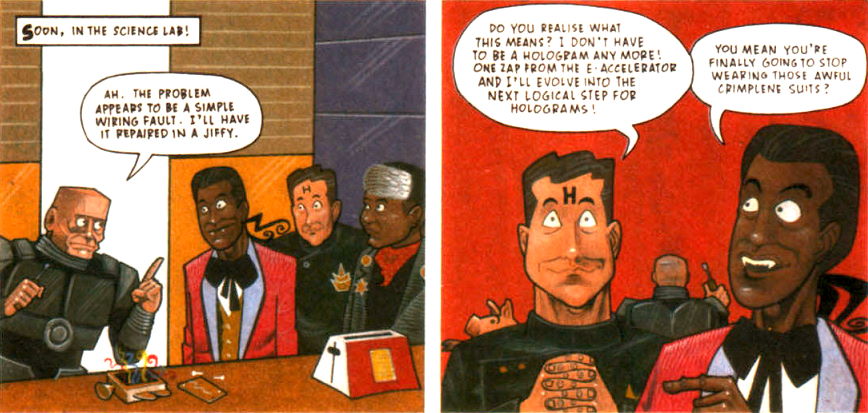
I also want to mention Evolution (vol 1 issue 12). It's hardly a smart story, nor one with grand ambitions, but it's one that makes the most of its cartoon sensibilities. Roger Langridge's art perfectly handles the off-the-wall slapstick without bogging itself down in photo-accurate caricatures, and sometimes that kind of dopey guff is all you want.
The comics in general tend to explore sci-fi concepts more literally and more casually than the TV show, obviously since they're not hindered by a BBC filming budget. It's certainly interesting, even if the results are often a tad blah; to see the Cat's wardrobe plundered by a culture starved of style, or Spare Head 3 terraforming a planet of living metal, it's the sort of stuff the show could only dream of doing with its limited resources, even if the writing's a bit wanting.
A lot of stories love playing with the Polymorphs; The Aftering is all about polymorph courtship, and even the Skutters have their own brush with one. Nigel Kitching's Home of Lost Causes in particular going above and beyond in what the monsters are capable of... though there comes a point where it feels like it goes off the deep end, when it's otherwise presenting such a simple thought exercise. Cracking imagery, though.
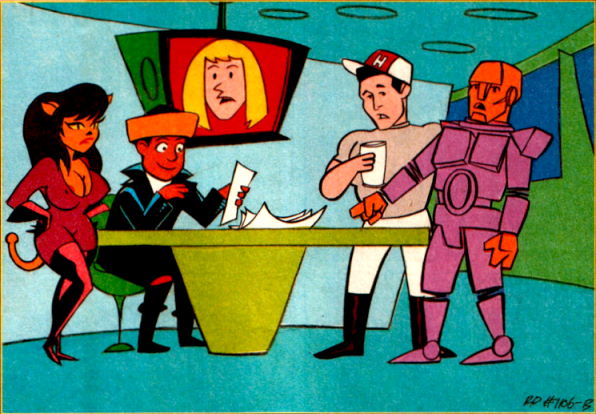
One of the things I loved about this era of Red Dwarf was the variety. The TV show was continuing to metamorphose into something more bombastic and adventurous, each series practically a different skew of action to comedy to drama. Then you had the books, which took such a wildly different approach they could easily have been a franchise unto themselves, but having that connective tissue is such an integral charm, to see familiar characters and settings explored in such a darker fashion...
And likewise, the comics are yet another skew on the material, the first stories to not be written by Doug and Rob to my knowledge. It's a bit hit or miss, of course, some of the talent not quite meshing with what we know of Dwarf. It's a pity there's no serialised content for it to form its own 'true' take on the story (such as it is), but the anthology approach is fun too.
I wish I could vouch for the rest of the magazine's content, but I mostly stuck to the interviews; the prosey bits got a tad overwrought for me to stick with it. If you've watched the DVD extras you'll have heard a lot of nuggets of information before, but it's nifty seeing it framed in a time capsule this way, referring to upcoming projects that may or may not have come to pass, things like that.
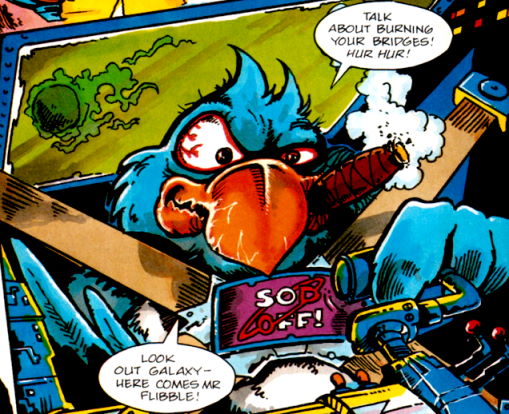
One of the most features I enjoyed the most were the retrospectives on series 1, with Rob Grant, Doug Naylor and Craig Charles offering their own insights on them, whether things panned out well or not. They're very scathing of their own work at times, confessing how some elements work on the page but not so much on screen, be it through the acting, the pacing, or even something as simple as the crappy sets. They're particularly ruthless about Waiting For God, acknowledging how it was looking to dig into their own established mythos, before realising that was a wrong turn to make.
It's interesting to see these judgments in hindsight; last I recall I was still partial to that episode, despite its flaws, but it does perhaps rub against the show's strengths, its characters and quirkiness; to immediately start picking at its seams this early is probably asking a lot. Then again, one could argue so much about the cat part of the story; it's there to introduce the Cat, natch, but what does he or the show gain from this historical baggage? Talk of the cats as a race was pretty much dropped after season 1, and only brought up in modern episodes seemingly as an apology to anyone still interested in that sort of thing.
I'll be frank, my reading material this year has not been especially highbrow, and I think the Smegazines dragged the bar down even further. Still, for every duff strip there's gonna be at least one that makes an impression. That and it stopped from just rewatching the whole bloody series again.
It's an offshoot of the franchise that's not talked about too often... probably for good reason, but, y'know, when you're obsessed with something, you tend not to ask if it's good or not. Not all one thousand pages of content are gonna be winners, but there's some good bits! If you are to check these out, just approach 'em as magazines. To treat the comics as the central column is going about it the wrong way and going to skew your expectations a tad.
Mad Dash Racing
Xbox
Nov 29 ~ Dec 05
Nov 29 ~ Dec 05

I really wish I could ditch my Xbox. It's a clunky piece of hardware that's temperamental even at the best of times, has more trouble playing discs than it does illegal homebrew, and I don't know what exclusive games it has I'd be in a rush to replay. But until a suitable alternative comes along, it stays because I need some way to experience Mad Dash Racing.
So... how many games are there in the on-foot sub-genre of racing games? Discounting olympics stuff, I'm worried that Sonic R, Bomberman Fantasy Race, PenPen TriIceLon and this are the only entries. And wouldn't you know it, they're all games I've fallen head over heels for at some point in my life, completely infatuated with the stupid, busted messes they invariably are.
With that preamble, you probably get the gist that this is a foot race starring funny animal characters -- WITH ATTITUDE. Quirky profiles and colourful language aren't enough to cut it, the racing takes cues from extreme sports, from grinding on rails to pulling aerial stunts, and drifting around corners like they're on skis. All that and it's backed by banging '90s techno, with tracks you're sure to have heard in the Mortal Kombat movie already.
The racing has a very unique flow to it -- if you play the game like a 3D platformer, the mechanics are going to feel all sorts of weird. A lot of important interactions occur with the X Button -- without it, you'd never know about grinding on rails or even how to turn good. On top of that, you're also asked to 'swirl' the right stick should you ever need to swim, climb ladders or muck about with pulleys. It's very Sonc Rivals in that regard, asking you suddenly swap out precise button presses for just mashing it 'til you make it.
It feels like there's a staggering amount of mechanics to keep on top of. Drifting's essential, as it gives you a speed boost depending on what colour your dust trail is, ala Mario Kart. Grinding's necessary to access certain paths and shortcuts. Holding the X Button in mid-air and spinning the stick will perform stunts, which nets you a boost and builds up Juice for every successful rotation.

Then there's Juice! Each racer is categorised as a Dasher, a Basher or a Glider, their respective powers fueled by Juice -- Dashers can scale steep slopes, Bashers bust through terrain, and Gliders can glide, natch. This means there's paths and shortcuts tied to each type... but by collecting 10 green meteor shards you gain access to all three abilities, at least until you get attacked. Areas accessed by an ability are marked by their icon, though they're so muddy it's hard to recognise them in the heat of the race; you just have to surmise that a glider's probably the only one who can cross that giant gaping chasm.
On top of Juice cans and meteor shards, there's hot sauce bottles that offer items. I did not understand half of them. In between shields and homing missiles, you can also drain other players' Juice and green meteors? There's a remote-detonated bombs that I never saw anyone use properly? And then there's buttons on the track that set off traps, be it spawning landmines, destroying terrain to create hazards, or opening new gateways...?
The game is absolute pandemonium. There are no safety barriers; you can get clobbered three times in a row by hazards and fellow racers without a chance to get up. You can get lost on where to go next because the camera would rather point backwards than where to go next. This is not a complaint I ever expected to lobby, but the game has too much collision detection. You can wedge yourself in the nookiest of nooks, be it between a wall and a tree or in the crevasse next to a cave entrance, when most racing games would just round off those edges.
Courses seem to average around 4 to 5 minutes long, and no matter how well you do or how far you lag behind, it almost always comes down to the wire. One particular course balances out its hazards relatively well, and then suddenly throws pits, swinging axes, floor spikes and landmines all in the final two bends before the goal!

The game has only eight courses, but they're extremely sprawling and dripping in setpieces. Jumping across teetering rocks, sliding down ski slopes, grinding on rails above lava... it gives Sonic Adventure a run for his money. Xbox games seemed to pride themselves on their data streaming tech, allowing for dense, enormous levels... that it's strange the game is just a racing game. Each course has enough landmass to make a 3D platformer jealous, almost all of them a single stretch with no laps to repeat, and yet it only has token gestures to give you incentive to explore them to the fullest.
Which is probably for the best, as the adventure mode has two 'duels' that are this close to roadblocks. The first has you trying to whittle the opponent's health to zero, preferably by staying ahead of him and triggering traps. If you lag behind it's this close to impossible to catch up, while if you maintain a good lead it's just sticking the course until you suddenly win. It's not very intuitive or entertaining.
The final level has you run three laps of the castle courtyard before you scale to the top, where you're tasked with defeating Hex before he activates his machine. This entails using all three abilities to dash up a slope, glide to the machine and then bash it, dealing marginal damage... and I was unaware this is only a preventative measure, the optimum method is to seek him out and clobber him yourself. I'm pretty sure doing it my way took nearly 20 minutes. It's... interesting to finally see the game lean towards something more 3D platformer-y, but it just seemed a cryptic way of going about it.
In terms of extra content, each course has three medals hidden in an ability-specific shortcut, and there's three challenge modes to try out, competing for time, stunts or cash. These modes drop the AI opponents, but still retain all the hazards and stage enemies you'd normally encounter, so your personal record's still going to run folly of any baddies in your way! Time trial is novel if just for finally getting to push the mechanics to their limit without risk of being hit by missiles or whatever.
It's here I learnt that the Dasher is well and truly busted. Jumping from any kind of boost offers a longer and better speed-up than if you were on foot... and since the Dasher can speed up at will, you can spend a tiny bit of energy and jump, getting you a boost that's just as potent. On straightaways you can make up good distance, and it's great for recovering on corners or from taking damage. The AI's rubber-banding probably prevents it from breaking the races wide open... but that remains to be seen.
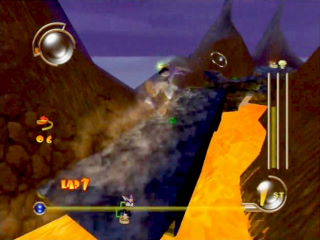
I honestly cannot find pleasure in the cash or stunt challenges. The former has you perform over 50 stunts before reaching the finish line, under a time limit that's only marginally more forgiving than time trial. Having to thrash the stick around constantly for tricks is exhausting, and the timer gives you very little wiggle room; botching a trick will cost you at least three seconds before you regain control, so there's no room for fuck ups.
Cash grab is a chance to explore as you have to collect 20 "Hex Dollars" strewn throughout the level. It's the only mode to encourage fully scouting out each level, a logical extension of Sonic R's token and balloon hunts... but it worked in that game because stages were so delightfully compact. And looping, too! To trek through a linear level for ten minutes and come up short is nothing short of miserable.
These extra modes make an earnest attempt to add content in the cheapest way possible, but they push at the boundaries of my patience. Knowing you need to complete eight of these challenges before you get a reward is enough to make me cry in despair. Unlocking Gex ain't worth this kind of trouble!
Yeah, Gex is in this. It makes me unreasonably upset that Bubsy isn't in the game too. I don't care if he had no reason to be in a Crystal Dynamics game. Fandom consensus in the wake of Gextra Life makes it impossible for me to see those two as anything but a disastrous couple. Bubsy can glide! He'd fit right in!
... is Sid the rebound? Did Gex decide he needed to meet new people, but was unable to pull himself away from snarky cats with lousy attitudes? We all have our types, Gex.
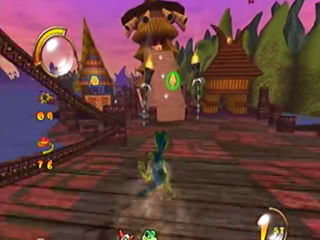
The tone is stupid and radiating in residual '90s energy, I can't help but love it. Its cartoon sensibilities are rooted in the attitude-driven crap of that era, everyone looking like they belong in a woeful mascot platformer or a line of snarky apparel, with personalities and appearances that are this close to offensive stereotypes. Its faux-edginess, random humour and occasional bad language give it a tryhard vibe at times, but in hindsight that only makes it more endearing.
Charles Martinet portrays a foul-mouthed Italian lizard who speaks in Luigi's voice and calls you a jerkoff. Another racer is a "wannabe-mafioso" alien who talks in tired gangster clichés... and the fact he's called a "wannabe-mafioso" implies this stupid cartoon world of incompetent nitwits has mafiosos who do their job properly. Maybe I'm reading that all wrong. I might be thinking about it too much.
Yet for every half-baked element, there's an inkling that there was some serious passion behind this world, from its course select that suggests lore and connections between all the tracks, to earnest attempts to recreate exaggerated 2D character designs in 3D.
The devs clearly had passion for it, though how much of that zeal was fully realised is another matter. Does it want to be a mad and frantic party game? Or does it want to aim for even the faintest whiff of finesse? The rubber-banding on the AI opponents is hard to credit; even while intentionally lagging behind to scout for medals, there was always one guy within walking distance, and even with some incredible leads, I'm assured to have the others right on my tail for the final stretch. It makes for exciting races where you're (hopefully) always within striking distance, but it turns the game into one enormous crapshoot.
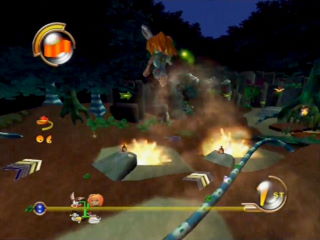
It's a pity, because it feels like a game that deserves better. With three extra challenge modes there's arguably a good drop of content... but everything beyond the base game looks so cheap. The menus are clunky and barely even acknowledge those modes; the stunt challenge menu is identical to the adventure menu, meaning you're not even told your objective unless you pause! Want to know what progress you've made? Better check the crap-looking Status screen, which is totally distinct from the also poorly-designed Records screen! I'll defend a lot of the game's decisions, but the menus are not one of them.
Sonic R made a splash on me and I always want to see how it can be iterated upon. Mad Dash has got a lot of ideas... almost too many. The game's extremely overwhelming at first glance, and its somewhat cheapskate approach to tutorials and presentation don't make it any easier. Trying to keep track of all the gimmicks and mechanics is a little bewildering, and for every instance where it feels like it streamlines things, there's something else that gives me a headache.
There's so little competition in this sub-genre that I'll take whatever pickings I can get, and in terms of scope, Mad Dash Racing is arguably the most robust it's got. I got the game for tuppence at CEX a few years back, and honestly, I wish I paid more. I wish I played this when it was new. It's exactly the type of weird cartoon crap that little me would've been totally enamoured with. If you put stupid cartoon characters in a completely impractical racing game then I will find it in my heart to love it, no matter how unworthy it may be of such devotion.
Metal Slug: 2nd Mission
Neo Geo Pocket
Dec 08 (Red Eye)
Dec 08 (Red Eye)

As much as I dig this game, I don't think I've ever played it for non-research purposes since... god, 2004, probably. It's hell year. Let's enjoy ourselves!
I played 1st Mission back in 2013 and covered most of the quirks of the Neo Geo Pocket series there -- without the beefy arcade architecture, it's left to compress the vibe of Metal Slug into something smaller, slower and less intense, instead favouring exploration, secret-hunting, and sheer variety.
The formula's much the same as the first game, retaining its branching paths and multiple exits per stage (some of them involving getting your vehicle blown to smithereens), but it all just feels that more polished. The control is smoother and snappier than the fudgy movement of 1st Mission, and by having different stories and missions split between the two characters, there's extra incentive to replay with a critical eye.
While the first game was limited only to the Metal Slug and Slug Flyer, this game introduces the Slug Sub (not the Slug Mariner, that's different!). Its stages are slightly more maze-like, forcing you to navigate between water currents to find the right pathway. It's a change of pace, I'll give it that, but it's not the sort of thing I'll be singing the praises of after the fact. Non-slug additions include using a jetpack or dinghy to escape from your destroyed vehicles, gimmickry like turrets and depth charge deployers to attack bosses...
... and perhaps most obnoxiously, minecart sequences. They only appear in the final level, but they're my number one source of wasted continues! It's the closest the game gets to the fast-paced, twitch-reaction stuff in the trickiest moments of the arcade games... but it's also the one time where fucking up will kill you instantly. Jumping over spikes is incredibly precise, and although you can slow down, reacting in time is extremely difficult. I had at least 20 continues by that point, but it sucks to burn through over half of them on such a contrived challenge.
That's probably my single beef with the game, based on a single playthrough, though. It's otherwise got such fun personality that I can't not love it. The sprites are adorable, boasting expressive animations and oozing with super-deformed charm; the fact half the weapons have unique sprites associated with them is really nifty. The only thing Metal Slug was missing was bigger guns!

The sheer variety of levels and locales is fascinating, from the frontlines to gulags, burning cities to dense jungles, frozen tundras, armoured trains... with the branching paths there's a fair few ways to see all these missions, and there's some iconic stages you might miss entirely on your first go-around! Seeing how it all connects on the overworld, and the radio communications with HQ relaying your current orders, it all adds such life to a series that otherwise coasts entirely on "go here, do this, shoot more dudes."
Knowing you're rattling out information from turncoat soldiers or what-have-you is nifty. And that's not even mentioning the prisoners, all 100 of which have unique portraits and dialogue, and reveal information pertaining to hidden secrets once you reach the required rank via collecting score items. It's a delightfully breezy single-run playthrough, but to come back and see everything else it's got is bound to be a treat, too. That's why the game mesmerised me nearly two decades ago!
Admittedly it's hard to say how much of what I'm writing is my current thoughts and how much is nostalgia permeating my judgment... but honestly, I'm just glad to play the game after all this time. And still have a blast, no less! I still mourn the lack of intense arcade challenge, but this remains an exciting and novel way of adapting the formula to handheld, giving the game stacks of content and incentive to revisit through sheer variety of secrets and setpieces.
Honestly, it's a pity it never got iterated upon, either via SNK themselves or through the many, many "inspired by" indie games. Admittedly saying your game is homaging the Neo Geo Pocket rendition of Metal Slug and not the arcade game is the sort of marketing that appeals to no one (IT'D GET ME TALKIN' THOUGH!!), but darn it, someone bash the two formulas together. All the exploration and secrets and branching paths and compact levels, just with combat that's a bit more engaging, y'know?
Transformers: Fall of Cybertron
PC
Dec 20 ~ Dec 21
Dec 20 ~ Dec 21

While I'm finishing off unexplored media, let's get around to that one Transformers game I missed out on, why not. I honestly can't tell if tying a bow on things is my theme this year, I just know it's what prompted me to finish off Red Dwarf and play a bunch of those Sonic games. To try and add thematic cohesion to this year's events (besides muffled screaming) seems like a farce, honestly.
I'm going about this all backwards, having played Dark of the Moon and Rise of the Dark Spark first, and only now going back to the game they used as a foundation. As you might have guessed, it's a sequel to War For Cybertron; that game's slightly contrived 3-player co-op is dropped in favour of each character having a unique gimmick, ranging from optic stealth to grappling hooks, to varyingly over-the-top ways of massacring everyone on screen. In this canon, Optimus Prime has a bombing squadron over his head at all times.
I should know what I'm getting into by now, but I still gotta gripe how it's more a cover-shooter with a Transformers slant, than a true designed-to-the-core Transformers game. You can't just stick a car behind waist-high cover, hence why they float around instead. Opportunities to drive at full pelt are few and far between, so you rarely get to savour the joy of running over dudes.
There's still instances where they shine; the first encounter with the Insecticons shows their strengths, being able to smoothly backpedal while letting rip, and then boosting through them if they get too close for comfort.
Another thing I take for granted is how idiot-proof the game is. Do people still gurn about how shooters have gotten dumber over the years? Because I still find myself boggled on where to go next; I just have trouble parsing 3D space! But this game is constantly flashing indicators on where to go next, lighting up key markers with illuminated outlines... and if it isn't giving directions, then you clearly haven't shot enough dudes yet.
This is the instalment to introduce character-specific abilities and gimmick characters, like the melee-centric Bruticus or rage-fuelled Grimlock. Each chunk of the game's usually got something unique in its favour; the introductory portion is steeped in hoo-rah military bro stuff, where you shoot the shit out of Decepticons as Optimus Prime while everyone cheers you on and says how cool you are.
It ditches the tiresome "Call of Duty for kids" vibe once it starts focusing on characters with fun repartee; Jazz and Cliffjumper and the Combaticons have entertaining byplay, and seeing Starscream act like a tittering prankster when he's committing subterfuge is a hoot. The character writing is good when it remembers it has characters, and isn't just playing army men.
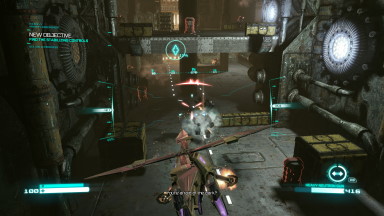
I've already played three games like it by now, but it's nice to have something that feels high-budget again. Dark of the Moon was painfully cheap despite its quality-of-life changes, and Rise of the Dark Spark coasted on having a big budget framework to build off of. This game looks the biz.
I could grumble about its desperate need for constant explosions and rabble to make the downtime between actions seem exciting, with extremely silly reasons to show bystanders get blown apart -- electrical interference will do that, apparently! -- but the game just looks swish.
The campaign takes a bit of a dip once you take command of Grimlock in a prolonged Dinobot rescue mission. Although full of keen imagery, his slower pace of combat is a bit of a slog, and the constant arena battles with little direction just drag on a bit.
The finale partially makes up for it in a bombastic ship-boarding battle as you constantly swap betwee factions, taking command of the boarding Decepticons before fending them off as the Autobots. Despite how much cinematic glitz the games coat their stories in, not much is actually accomplished in the grand scheme of things. Did Megatron ever have a goal in mind, or was being a petty bitch about the sum of it?
Dinobot lulls aside, the game's otherwise a fun, breezy experience (at least on easy difficulty!), an entertaining way to spend a couple of evenings. It's been a hot minute since I played War For Cybertron, but I recall its boss fights being boring, drawn-out messes... and while this game has the occasional overwrought encounter, it dabbles more in setpieces and arena brawls when outright boss battles, per se.
Some of the larger skirmishes with Cliffjumper and Megatron are pretty tough, but on the whole it's all pleasant enough. Nowhere near the same obnoxious roadblocks as in DOTM or RotDS... besides the occasional glitch that required restarting from the last checkpoint. I think that's just symptomatic of modern games...!

It's just a pity all the replay value has since gone offline -- the multi-player is strictly online-only, as is the wave-attack Escalation mode, meaning you better milk that campaign for every drop of entertainment you can get. Want to play as the other Dinobots or multi-player exclusive characters? You can't anymore, bitch!
This is probably just a pet peeve of mine, but I wish more games just had, like, modes built for short and sweet setpieces. I don't care about the rest of the level, just lemme play a wave-attack or a challenge mode or a cool self-contained battle when I want, with whatever characters and guns I want. I can probably blame this on Lost Planet 2 and so many other games hiding cool shit behind their unpopulated or outright defunct multi-player modes. It's been eight years but I'm still salty!
It's arguably a smoother experience than War For Cybertron, but perhaps not as compelling in terms of mission structure and narrative, at least from what I recall. Playing it scratched an itch, but it only made me more depressed how Transformers games so rarely hit my sweet spot. Devastation might just be a Platinum game in G1 clothing, but its sense of kinetic fast-paced combat is hard to top. I'll never get the perfect Transformers game I'm still spitballing in my head. Not unless I learn Unity first! And accept getting C&D'd into the dirt!